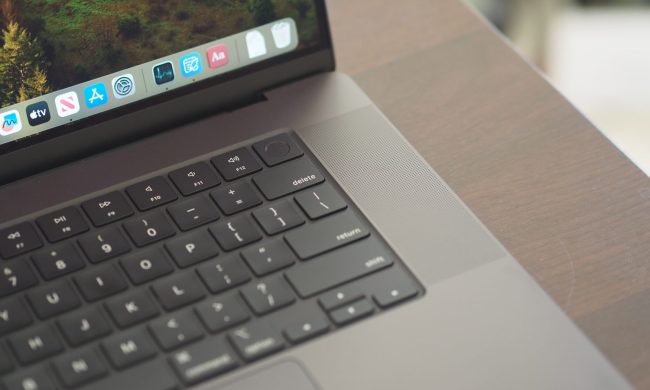
- Excellent GPU performance
- Compact and beautiful design
- Impeccable build quality
- Battery life is fantastic
- Better multimonitor support
- Limited ports
- M2 might be better value
The MacBook Air is the world’s bestselling laptop, according to Apple. That was true before the M3, and it’ll likely be true a year from now.
On one hand, that means the inclusion of the M3 chip is easy to overlook or write off. And with the M2 MacBook Air selling for just $100 less (it’s discounted even more at some retailers), the M3 needs to prove itself. Some people will probably still be better off saving their money and buying the M2 MacBook Air, but the way the M3 supercharges this laptop’s GPU performance is downright impressive.
Specs and pricing
| MacBook Air (M3) | |
| Dimensions | 11.97 x 8.46 x 0.44 inches |
| Weight | 2.7 pounds |
| Processor | Apple M3 (8 core) |
| Graphics | 8 core GPU 10 core GPU |
| RAM | 8GB unified memory 16GB unified memory 24GB unified memory |
| Display | 13.6-inch 2560 x 1664 LED IPS display at 60Hz |
| Storage | 256GB SSD 512GB SSD 1TB SSD 2TB SSD |
| Touch | No |
| Ports | 2 x USB-C with Thunderbolt 5 1 x MagSafe 3 for charging 1 x 3.5mm audio jack |
| Wireless | Wi-Fi 6E and Bluetooth 5.2 |
| Webcam | 1080p FaceTime HD camera |
| Operating system | macOS Sonoma |
| Battery | 52.6 watt-hour battery |
| Price | $1,099+ |
The 13-inch M3 MacBook Air starts at $1,099, replacing the price of its predecessor, the M2 MacBook Air. Apple is still selling the M2, however, for $100 less at $999.
This starting configuration comes with 8GB of RAM, 256GB of storage, and an 8-core GPU. Apple charges $100 to go from 8 GPU cores to 10 GPU cores, which is only available on the 13-inch model. The 15-inch MacBook Air starts at $1,299, and comes with the 10-core GPU.
Both sizes can be maxed out at 24GB of RAM and 2TB of storage, with the cost rising well over $2,000.
Design
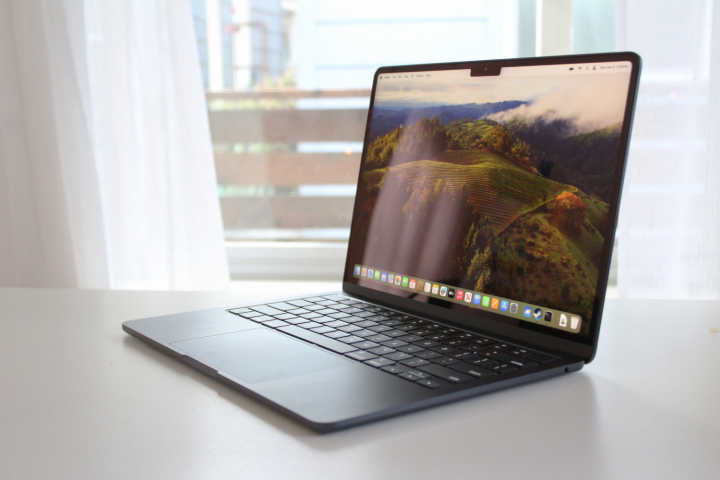
The MacBook Air is a stunning laptop. It remains the most extreme example of the Apple Silicon era, thanks to a design that is thin in a way that just wasn’t possible in the past. At 0.44 inches thick, it remains the thinnest clamshell laptop of this kind that’s ever been made. It’s also the most powerful laptop without a single fan.
So yes, the MacBook Air’s title as thinnest laptop is impressive, but let’s be honest: the difference between 0.44 inches and 0.5 inches is hardly noticeable unless you have two machines side by side. Windows laptops like the Asus Zenbook S 13 and Samsung Galaxy Book3 360 come fairly close to matching the MacBook Air’s compact nature.
Fortunately, the MacBook Air has a lot more than just thinness on its side. It’s also extremely well-built, which can sometimes be a concern when devices get this thin. We all remember #flexgate from 2019, right? Well, let’s just say many laptops this thin (including older MacBooks) have struggled to remain perfectly rigid under pressure. Not so with the current MacBook Air. It’s as robust as laptops get.
The Midnight Black color is great to see come to the MacBook Air.
Now, none of that is new with the M3 MacBook Air. This design has been in use since the M2 MacBook Air came out in 2022.
The one new exterior element on the M3 MacBook Air is a new color option, Midnight. Something very similar launched on the M3 MacBook Pros last year, and I’m happy to see it also available on the two MacBook Air sizes. It’s a great color, even if I still prefer Space Gray personally. Apple says its supposed to reject fingerprints better than other color options, but in my extended time with the Space Black MacBook Pro, I can’t say it looks much cleaner in the long run.
Nothing is new here in regard to the keyboard and trackpad. They’re both excellent, as always, offering exceptional typing and incredibly precise tracking. Apple’s oversized haptic feedback trackpads were the first in the business, and though they’re becoming more common, Apple’s still might be the best.
Ports
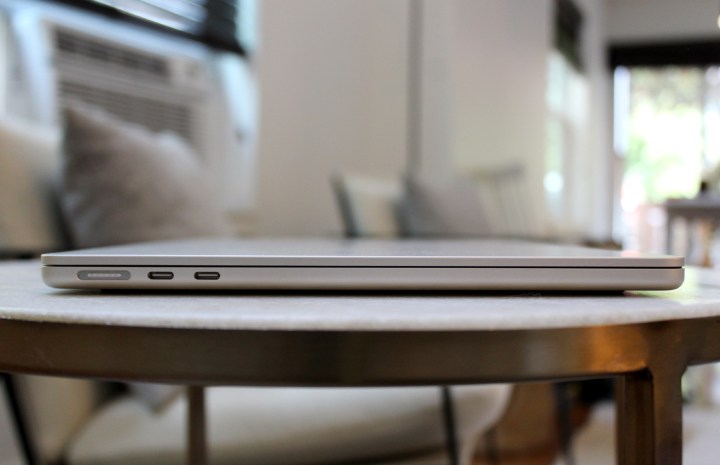
One of the most concerning limitations of the MacBook Air is the number and variety of ports it offers. It’s not that restricting you to only Thunderbolt 3 via USB-C is uncommon these days. All sorts of laptops have followed Apple down that path. But with the MacBook Air, it comes with some significant restrictions on external displays.
In the past, the M2 MacBook Air could only support one external display, regardless of the resolution and refresh rate. There are ways to get around this, but it requires a dock and some extra software to jump the hurdle. Apple’s never actually explained this limitation, but we assume it has to do with limited bandwidth of the base M3, as it also applies to the M3 MacBook Pro.
With the M3 MacBook Air, though, this gets marginally better. The M3 model (whether 13-inch or 15-inch) can now officially support two external 5K monitors (at 60Hz), but there’s a catch. The lid of the MacBook Air needs to be closed. So, the system can still really only support two displays, as the moment you open the laptop, one of the external monitors will turn off.
It’s a nice improvement over the M2, and for some people, it may actually solve the problem. If you’ve always wanted to power a dual-monitor workstation setup with just a MacBook Air, this will do the trick. If you actually want to use your MacBook Air with those two displays, though, you’ll still have to opt for an M3 Pro or Max MacBook Pro. It’s one area where Windows laptops have a serious advantage over the MacBook Air.
Beyond the two Thunderbolt 3 displays, you also have a MagSafe 3 charging port on the left side and a headphone jack on the right. It’s a little frustrating to have all your power access only the left. Adding one more USB-C would have gone a long way.
Beyond ports, the MacBook Air M3 gets updated to Wi-Fi 6E and Bluetooth 5.3, the latest wireless connection standards.
Display
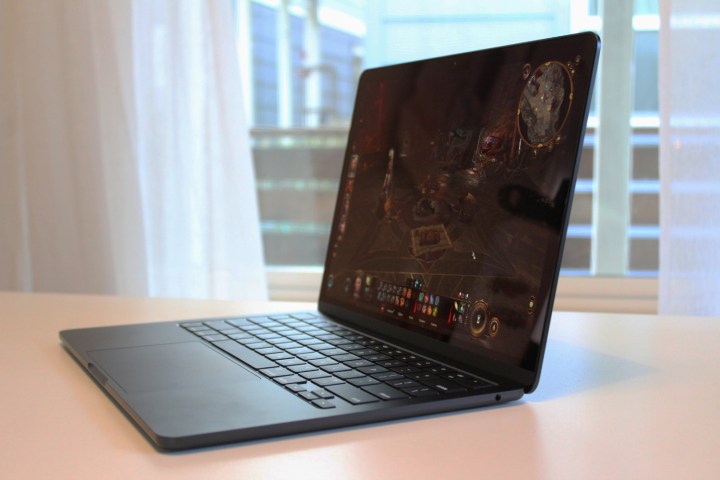
The 13.6-inch screen on the M3 MacBook Air I reviewed is exactly what you’d expect it to be. For an entry-level MacBook, it’s fantastic. Extremely sharp, with a resolution of 2560 x 1664 and pixel density of 224 ppi (pixels per inch).
No, it doesn’t have the array of local dimming zones and faster refresh rate of the MacBook Pro. Of course not. But for a laptop of this price, the MacBook Air’s display is plenty colorful, with lots of contrast and good enough color accuracy. More than that, Apple is always good about pushing the brightness of these LED screens to the max. My testing with my colorimeter on this one maxed out at 495 nits at full brightness. Color coverage is quite good too, hitting 87% of AdobeRGB and 99% of DCI-P3.
I should say, however, that OLED displays are becoming increasingly common in this price range. It’s not the default, but companies like Asus are really moving things forward, throwing OLEDs even on laptops under $1,000, like the Zenbook 14. These OLED screens have much better contrast, obviously, but also better color coverage and much better accuracy.
I still think the MacBook Air screen is competitive, but it’s no longer the obvious leader in the category. For example, a Delta-E of 1.24 is still good enough for what you’d need this laptop for, it’s just not as accurate as some of the OLED options out there. None of this has changed from the previous model, of course.
Performance
Like each step up in Apple Silicon so far, the M3 doesn’t provide a huge leap ahead in CPU performance. The M3 is 13% faster in single-core performance and 10% in multi-core, as tested in Cinebench R24. This is, as you would guess, probably not worth upgrading for nearly anyone. That’s especially true since this is a MacBook Air we’re talking about, not a MacBook Pro. Those that actually intend to push the MacBook Air beyond some office apps, multitasking, and web browsing, however, may not find a noticeable difference in CPU performance.
I should say, however, a 13% jump in single-core performance is pretty impressive compared to standard gen-over-gen Intel chips. When you’re already in the lead, another 13% jump doesn’t hurt. These are already at the top of their class in single-core performance, and with the M3, they get slightly faster, and are still well ahead of the competition from Intel or AMD. As seen in both Geekbench 6 and Cinebench R24, the MacBook Air M3 is more in line with its competitors in terms of multi-core performance rather than out in the lead.
Simpler tasks like video encoding in Handbrake allow for laptops with active cooling to zoom past the M3 MacBook Air. But just check out that score in the Pugetbench Premiere Pro benchmark, which tests the laptop in all sorts of video editing tasks. The fact that the M3 MacBook Air beats the XPS 14 — even with its discrete RTX 4050 — is seriously impressive.
| Cinebench R24 (single/multi) | Cinebench R24 (GPU) | Handbrake (seconds) |
Pugetbench Premiere Pro | |
| MacBook Air (M3) | 141 / 601 | 3049 | 109 | 3633 |
| MacBook Air (M2) | 122/ 542 | 1737 | 119 | n/a |
| Asus Zenbook 14 (Core Ultra 7 155H / Arc) | 103 / 493 | n/a | 86 | 1583 |
| Dell XPS 14 (Core Ultra 7 155H / RTX 4050) | 101 / 681 | 5738 | 84 | 3274 |
A large reason is due to the improved GPU, which is really the star of the show. With the 10-core unit I reviewed, the M3 is a whopping 43% faster than the M2 in graphics, as tested in the Cinebench R24 GPU test. Much of this is thanks to Dynamic Caching, a memory efficiency technology first introduced by Apple with the M3. The result is dramatically enhanced GPU performance that make the M3 stronger in all sorts of tasks, including video editing, 3D modeling, and gaming.
Many of this laptop’s direct competitors rely on Intel’s integrated Arc graphics, and regardless of how much those have improved this year, the M3 remains in the lead.
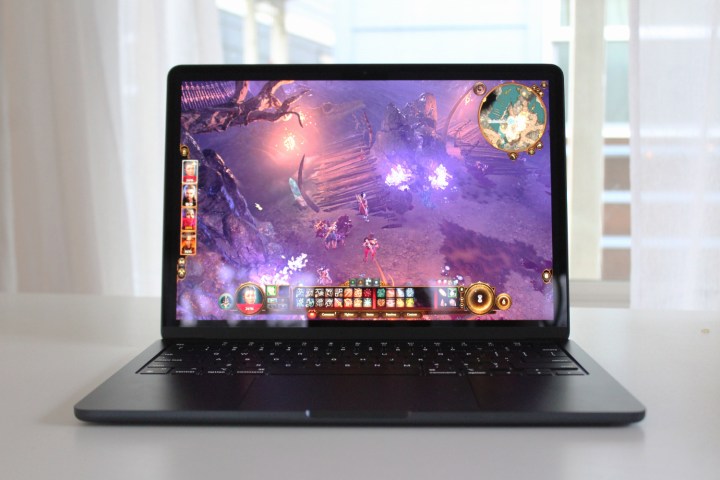
I did a deeper dive into whether or not the M3 makes the MacBook Air a somewhat capable gaming laptop. On the whole, I wouldn’t say that it does. However, do not buy this laptop for the purpose of playing games. However, if you do want to dabble here and there, the M3 MacBook Air can squeeze out some decent frame rates in even the latest crop of flagship games on the Mac.
I tried playing Baldur’s Gate 3, Resident Evil 4, and Death Stranding Director’s Cut. All three required some time spent in the settings — tweaking resolution, toggling graphics settings, and trying all the upscaling modes to strike a suitable balance between performance and visuals. I’m happy to report that it’s possible to get 40 frames per second (fps) to 50 fps in these games without resorting to making the game look like a complete mess.
And that’s a first for the MacBook Air. Never before has a passively cooled system this thin been able to play games at this level. Remember: gaming (or doing anything) on the MacBook Air is completely silent. Not a peep from the fans. And while surface temperatures can certainly elevate during heavier tasks, they never get uncomfortably hot, even around the keyboard and palm rests.
Battery life
It’s no secret that MacBooks have a killer upper hand over Windows laptops in the battery life department. It’s just not close, and I have to say that in nearly every laptop review I do these days, but it’d be detrimental to not consider that fact when choosing your next laptop. The M3 MacBook Air doesn’t change that in any way, still lasting for over 19 and half hours in our light web browsing test. Now, obviously, using the laptop for actual work will drop that by a few hours at least, but remember — this laptop’s competitors only last for around 7 or 8 hours on average in this same test.
Beyond just the advantage of being able to work away from an outlet for longer, the MacBook Air doesn’t lose performance when it’s not plugged in. Running heavy applications might drain your battery faster, but it’s not going to slow down tasks like it would on a Windows laptop.
Webcam and speakers
The MacBook Air comes with a capable 1080p webcam built into the notch at the top of the screen and fantastic set of speakers. It’s one of the better videoconferencing laptops you can get at this price, and it’s not bad for watching content on either. However, you should know that this is one of the few areas where there’s a notable difference in quality between the 13-inch MacBook Air and the 15-inch MacBook Air. The 13-inch model only has a four-speaker setup, while the 15-inch has two extra speakers, matching the MacBook Pro.
That doesn’t mean the smaller Air has poor speakers — not at all. These are still class-leading compared to many of this laptop’s direct competitors. They just don’t have the full-bodied sound and robust bass that the 15-inch model is able to produce.
Should you buy it?
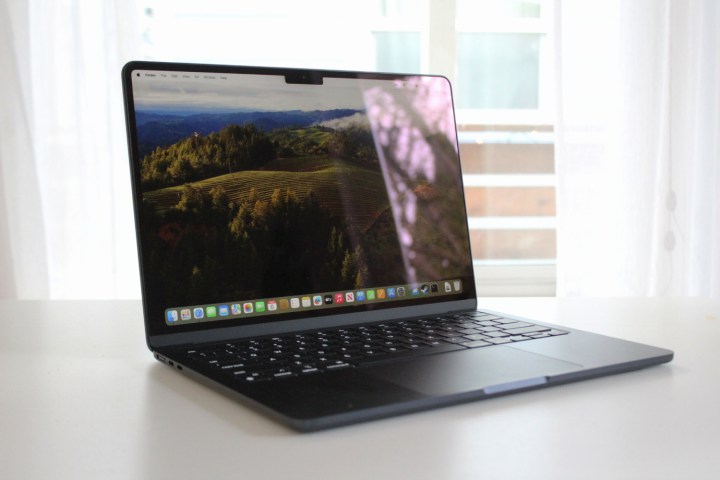
If you’re upgrading from the M2, absolutely not. There’s not nearly enough new here to make it worth an upgrade from the M2 MacBook Air. But if you’re coming from the M1 MacBook Air (or an older MacBook), you’ll be delighted by the M3 MacBook Air. The GPU performance is excellent, and the ability to support two monitors will be a game changer for some, even if it requires keeping the lid closed.
If you’re considering this against many of the comparable Windows laptops in this price range, you’ll again find that the M3 MacBook Air outclasses those laptops in almost every way.
Put simply, the M3 MacBook Air is still one of the very best laptops you can buy, and it’s a solid value for the price. But if you’re not someone who will really need the extra GPU performance, you’re better off saving some money and getting the M2 MacBook Air.

